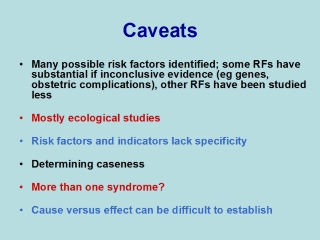| front |1 |2 |3 |4 |5 |6 |7 |8 |9 |10 |11 |12 |13 |14 |15 |16 |17 |18 |19 |20 |21 |22 |23 |24 |25 |26 |27 |28 |review |
 |
There are a number of caveats. Many possible risk factors have been identified; some RFs have substantial if inconclusive evidence (eg genes, obstetric complications), others have few supporting studies but have biological plausibility (eg nutrition), yet others have few supporting studies but with less obvious plausibility (eg ionising radiation) The associations found between schizophrenia and many proxies and possible risk factors – such as migration or influenza epidemics – are based on population-level observations and may not relate to individual exposure (the ‘ecological fallacy’) Many risk indicators and risk factors for schizophrenia exist but none appear completely specific to schizophrenia: they are apparent, often to lesser extents, in other related disorders. Lack of specificity of risk indicators and factors, together with the overlap with normal populations, prevents prediction of risk for schizophrenia in an individual. Similarly, caseness can be difficult to establish because schizophrenia and other related psychoses (eg bipolar disorder) may share similar risk factors – together with some overlap of symptoms. Conversely, differences in risk factors, age-of-onset and symptom patterns within schizophrenia suggest that the disorder itself may be comprised of a number of syndromes Cause and effect are sometimes difficult to establish; for example childhood social isolation may be considered (a) an effect of cognitive dysfunction or (b) an independent risk factor for schizophrenia. |